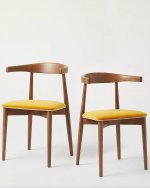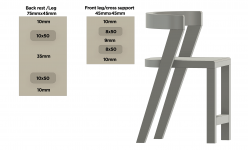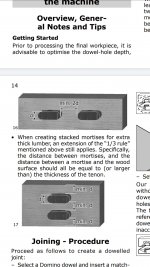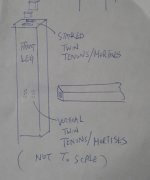You are using an out of date browser. It may not display this or other websites correctly.
You should upgrade or use an alternative browser.
You should upgrade or use an alternative browser.
Domino Chair Build with Angles
- Thread starter Tukston
- Start date
Crazyraceguy
Member
- Joined
- Oct 16, 2015
- Messages
- 5,435
My concern is more the structural integrity of the front legs. They are totally unsupported in any way. Building something to look like that drawing is one thing, but actually sitting on it? If you tied the legs together with a stretcher of some kind, it would strengthen to whole assembly a lot. It would drastically change the look though.
Crazyraceguy's comment drew my attention to the front part of the chair as my focus was on the angled mortises only, with apologies. I now realize that your sketch is a little different from this that I had in mind:
[attachimg=1]
The front legs need to be attached to the seat in such a manner that they can handle the shear force. To do that, stretchers as Crazyraceguy suggested, are one way. Or the legs can be attached to the notched seat, similar to what's shown in the curved chairs above (but a DF700 or a router/jig would be needed for the reach).
[attachimg=1]
The front legs need to be attached to the seat in such a manner that they can handle the shear force. To do that, stretchers as Crazyraceguy suggested, are one way. Or the legs can be attached to the notched seat, similar to what's shown in the curved chairs above (but a DF700 or a router/jig would be needed for the reach).
Attachments
Tukston said:Yeah, I plan to join the leg to the seat with a domino. The leg sits under the seat - 45mmx45mm in dimensions.
Lincoln said:How will you join the front legs? As per your drawing, where they join to the underside of the seat?
Just saw this reply. On second thought, such a joint using a twin tenon might survive the shear stress in the absence of any stretcher.
I'd build a prototype chair (half side) with 2x4 material to test both the angled jig and joinery strength.
Crazyraceguy
Member
- Joined
- Oct 16, 2015
- Messages
- 5,435
ChuckS said:Tukston said:Yeah, I plan to join the leg to the seat with a domino. The leg sits under the seat - 45mmx45mm in dimensions.
Lincoln said:How will you join the front legs? As per your drawing, where they join to the underside of the seat?
Just saw this reply. On second thought, such a joint using a twin tenon might survive the shear stress in the absence of any stretcher.
I'd build a prototype chair (half side) with 2x4 material to test both the angled jig and joinery strength.
That was my point about the front legs. I just can't see the seat slab taking the forces chair use. Chairs are quite different for tables. Sure, tables get moved, and that is usually the worst thing to happen to them, but it's not like a chair. The force on a table in generally just gravity, straight down. Chairs take side loads and a lot more movement.
You could glue that up with two tenons, oriented either way and the wood of the slab will most likely be the fail point, splitting along the grain when enough force is applied.
The rear legs are at least tied to each other by the backrest. That adds a ton of strength to them, plus the fact that they are connected to the slab out in the middle, rather than a corner. You could even "let them in" to a dado, even a shallow one would add a lot of strength there. None of that is helping those front legs. They are just "out there" with no support (and no real way to add any without changing the look)
cpw
Member
I agree that the front legs are the weak point. When designing a chair (or table); you have to think about what is going to happen when someone stands on it as opposed to using it the way you intended.
Thank guys for pointing out the weakness in the design. You bring up a very good a point.
I have included a cross support in the design so that there are 2 points of connection for the front legs. I am hoping the thickness of the wood combined with the support beam should do the trick. Ideally I should also have a cross support beam from front to back but I am hoping the thickness of wood will be enough for general use.
I have looked at domino placing and I see the rule of thumb is to have twice the thickness of the domino space between each domino. Regarding the front leg, I should really be using 6mm domino (according to the rule) but looking at it I kinda feel like the 8mm is the better option as far as strength goes. Does anyone have thoughts on the placement of dominos for strength?[attachimg=1]
I have included a cross support in the design so that there are 2 points of connection for the front legs. I am hoping the thickness of the wood combined with the support beam should do the trick. Ideally I should also have a cross support beam from front to back but I am hoping the thickness of wood will be enough for general use.
I have looked at domino placing and I see the rule of thumb is to have twice the thickness of the domino space between each domino. Regarding the front leg, I should really be using 6mm domino (according to the rule) but looking at it I kinda feel like the 8mm is the better option as far as strength goes. Does anyone have thoughts on the placement of dominos for strength?[attachimg=1]
Attachments
Steve1
Member
I like how you added the taper to the rear legs. Looks better (and stronger joint).
You might want to try the same on the front legs.
You might want to try the same on the front legs.
Crazyraceguy
Member
- Joined
- Oct 16, 2015
- Messages
- 5,435
There you go. That lower stretcher will help a lot.
Grain direction of the seat slab?
Grain direction of the seat slab?
Similar threads
- Replies
- 11
- Views
- 24K
- Replies
- 7
- Views
- 17K




